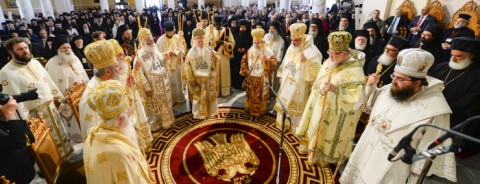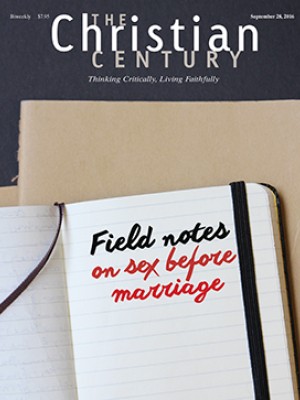The Great and Holy Council maps an Eastern Orthodox future
After the global meeting in Crete, conciliarity and orthodoxy hang in delicate balance.

Perhaps the most significant thing about the Great and Holy Council of the Orthodox Church that met in June in Crete is that it took place at all. The Eastern Orthodox churches hadn’t met in this way in nearly a century, and it was their first meeting since the fall of the communist regimes that had decimated the religious landscape of Eastern Europe, home to the majority of Orthodox Christians. Even if the decisions taken at the council are contested, there is now a mechanism in place by which they might be revisited.
In the Orthodox Church, nothing happens quickly. Yet the ripples of conciliarity being felt from the June meeting are significant, and they will not soon die out. Some within the Orthodox Church are proposing regular meetings, perhaps not unlike the Lambeth conferences held every decade in the Anglican Communion. Regular assemblies like this would be something new, and all of a sudden they feel more possible.
Read our latest issue or browse back issues.
The Eastern Orthodox Church is composed of 14 self-governing churches (15 if you count the Orthodox Church in America, whose independent, self-governing status is contested). Of these, four did not attend, largely due to disagreements over some of the texts that were to be discussed in Crete.
In a church that is famously resistant to change—especially when it feels rushed—the weeks prior to the council saw a flurry of activity, so much that some of the churches felt it would be safer to postpone the council. But the council convened anyway, with the churches of Russia, Georgia, Bulgaria, and Antioch staying away. Even with their absence, the council brought together hundreds of leaders, clergy, monastics, lay delegates, and advisers, and it managed to address all the documents before them.
As is the case with all councils since the ecumenical councils of the first millennium, the work of the Holy Council awaits a process of reception within the churches themselves, each of which will decide on the status of the council’s decisions and the texts it created. That process has already begun, with some of the four absent churches contesting the authority of the decisions.
A key area of discussion had to do with the internal ordering of the Orthodox Church in the face of modern demographic realities. Especially owing to the huge increase in migration in the past two centuries, the historic Orthodox churches of Eastern Europe and the Middle East all have significant communities—sometimes outnumbering those at home—in Western Europe, the Americas, Australia, and New Zealand. Each traditional Orthodox nationality established its own satellite Orthodox church abroad, and each church—Greek, Serbian, Romanian, etc.—is answerable to its “mother church” overseas. In many North American cities, one is likely to find a Greek Orthodox church and a Russian Orthodox church, and perhaps also Serbian, Romanian, and Antiochian churches, as well as a church that belongs to the Orthodox Church in America.
Orthodox churches outside their historic homelands are sometimes termed “diaspora” communities, a name that is resisted by those who feel it delegitimizes their function in the Orthodox Church. The problem of governing those churches hasn’t exactly shaken the rest of Christendom, but it has been a significant issue for the Orthodox, because technically there ought to be just one Orthodox bishop per locality and a unified Orthodox presence in every region. In that way it is clear that the church is not primarily an ethnic reality but simply “The Church,” residing in different localities.
The council acknowledged the current status quo as an anomaly, but found it unrealistic to move directly to a single Orthodox administration holding together the ethnically diverse churches. It reaffirmed the interim solution instituted in 2009, which calls for regional assemblies of bishops, representing all the Orthodox churches in the region (the United States and Canada; Latin America; Great Britain and Ireland; etc.), to meet to work toward an administratively unified Orthodox Church there.
Other discussions concerned the marriage of priests. Orthodox Christian priests may be married, but the question has arisen whether they may be remarried after being widowed or divorced. They cannot, the council reaffirmed, because marriage is forbidden once a person is already ordained to the priesthood.
The question of same-sex marriage and civil unions received attention as well. Churches locally are trying and sometimes succeeding at discussing the issue pastorally. Though this issue stirs deep emotions in the Orthodox Church as in other churches, it is not actually dividing the Orthodox. The Orthodox Church, as it restated at the council, does not allow its members to contract same-sex unions or pursue any other form of cohabitation other than heterosexual marriage.
The most controversial issue at the council might surprise a Protestant readership: it had to do with whether one can use the word church for any Christian group outside the Orthodox Church, and if so, in what sense. The Orthodox Church has historically identified itself as the “one, holy, catholic, and apostolic church,” the same body established with the apostles in the first century.
With increased communication and migration in the late 19th and early 20th centuries, Christian bodies increasingly came into contact with one another, and so began the ecumenical movement. Orthodox churches joined others in seeking to discern the spiritual and sacramental status of Christians outside their fold.
There is a certain diversity of views on that subject within the Orthodox world, but no Orthodox has proclaimed that all of the world’s Christians together constitute The Church, the Body of Christ. Rather, all have said that the Orthodox Church is The Church, and that those divided from it are in some degree of separation.
Although it may be easy to identify that position with arrogance—who do we think we are, calling ourselves and nobody else The Church?—Orthodox argue the point from the perspective of history and doctrine. Orthodox believe that while some disagreements needn’t have divided Christians over the centuries—they were largely terminological or cultural in character or concerned matters that cannot be known—other disagreements rightly divided the church because there was a correct and an incorrect position. The Orthodox Church therefore understands itself as The Church from which the others divided.
The Roman Catholic Church understands itself in virtually the same way. In a sense, so does much of evangelical Christianity, which considers the Orthodox believers in Eastern Europe as subjects for conversion to Christ rather than as members of the church or even as Christians. Mainline Protestants and Anglicans, on the other hand, tend to see themselves as parts of The Church, or as “the-church-together-with-other-churches.” But to an Orthodox Christian that approach makes no sense. As the Orthodox see it, not only are some of the divisions between the churches significant enough to divide them, the divisions within the mainline and Anglican churches are sometimes even greater, with some leaders denying Christ’s divinity and still being considered within the limits of a tolerable or even welcome diversity.
The council agreed that non-Orthodox bodies may be called churches, at least in recognition that this is what they call themselves and this is how they are historically known. Whether that name imparts any doctrinal status to them was left an open question.
This question of whether there is “church” outside the Orthodox Church is so divisive that several groups have challenged the orthodoxy of some of the church’s most high-profile theologians and leaders—including the ecumenical patriarch himself—who are seen as being too lenient on this matter and as selling away the unique treasure of Orthodoxy. These protesters deplore any Orthodox participation in official inter-Christian dialogues.
The council strongly rebuffed these voices by affirming those dialogues and adopting guidelines for how they are to be approached and received. The council even made explicit mention of the important role of the World Council of Churches and other global and regional ecumenical organizations.
Holding a meeting of this nature after so many years is a momentous event. It is an affirmation of the Orthodox Church’s conciliar nature. But conciliarity is never simple, especially when one has fallen out of the habit. It requires humility, adaptability, deep listening, and the appropriate exercise of authority. We may say that all of these were in evidence before, during, and after the June council, and also that all of them were manifest imperfectly.
The Orthodox Church has again shown itself as a living body, whose members are struggling to heed the calling to be in council with one another. That struggle is taking place in a church that is lagging in its responsiveness to modern demographic realities and to modernity in general. So was the Great and Holy Council indeed great and holy? That question requires two answers: “yes,” and “we’ll see.”
A version of this article appears in the September 28 print edition under the title “Great and Holy Council.”





